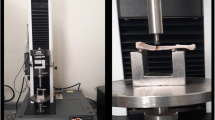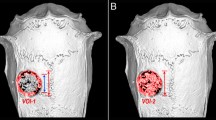Abstract
The disadvantages of current bone grafts have triggered the development of a variety of natural and synthetic bone substitutes. Previously, we have described the fabrication, characterization, and short-term tissue response of poly(1,8-octanediol-co-citrate) (POC) with 60 weight % hydroxyapatite nanocrystals (POC-HA) at 6 weeks. In order to better understand the clinical potential, longer term effects, and the biodegradation, biocompatibility, and bone regenerative properties of these novel nanocomposites, POC-HA, POC, and poly-L-lactide (PLL) were implanted in osteochondral defects in a rabbit model and assessed at 26 weeks. Explants were stained with Masson Goldner Trichrome and the fibrous capsule and tissue ingrowth measured. In addition, the bone-implant and bone-cartilage response of POC-HA, POC, and PLL were assessed through histomorphometry and histological scoring. Upon histological evaluation, both POC-HA and POC implants were biocompatible, but PLL implants were surrounded by a layer of leukocytes at 26 weeks. In addition, due to the degradation properties of POC-HA, tissue grew into the implant and had the highest area of tissue ingrowth although not statistically significant. Histomorphometric analyses supported a similar osteoid, osteoblast, and trabecular bone surface area among all implants although the fibrous capsule thickness was the largest for POC. Moreover, histological scoring demonstrated comparable scores among all three groups of the articular cartilage and subchondral bone. This study provides the long-term bone and cartilage response of novel, citric acid-based nanocomposites and their equivalence to FDA-approved biomaterials. Furthermore, we provide new insights and further discussion of these nanocomposites for orthopaedic applications.






Similar content being viewed by others
References
Mistry AS, Pham QP, Schouten C, Yeh T, Christenson EM, Mikos AG, Jansen JA. In vivo bone biocompatibility and degradation of porous fumarate-based polymer/alumoxane nanocomposites for bone tissue engineering. J Biomed Mater Res A. 2010;92:451–62.
Navarro M, Michiardi A, Castano O, Planell JA. Biomaterials in orthopaedics. J R Soc Interface. 2008;5:1137–58.
Wei G, Ma PX. Structure and properties of nano-hydroxyapatite/polymer composite scaffolds for bone tissue engineering. Biomaterials. 2004;25:4749–57.
Zhang R, Ma PX. Porous poly(L-lactic acid)/apatite composites created by biomimetic process. J Biomed Mater Res. 1999;45:285–93.
Zhang R, Ma PX. Poly(α-hydroxyl acids)/hydroxyapatite porous composites for bone-tissue engineering. I. preparation and morphology. J Biomed Mater Res. 1999;44:446–55.
LeGeros RZ. Properties of osteoconductive biomaterials: calcium phosphates. Clin Orthop Relat Res 2002;(395):81–98.
Nejati E, Firouzdor V, Eslaminejad MB, Bagheri F. Needle-like nano hydroxyapatite/poly(l-lactide acid) composite scaffold for bone tissue engineering application. Mater Sci Eng C. 2009;29:942–9.
Furukawa T, Matsusue Y, Yasunaga T, Shikinami Y, Okuno M, Nakamura T. Biodegradation behavior of ultra-high-strength hydroxyapatite/poly (l-lactide) composite rods for internal fixation of bone fractures. Biomaterials. 2000;21:889–98.
Chung EJ, et al. Early tissue response to citric acid-based micro- and nanocomposites. J Biomed Mater Res A;96:29–37.
Olszta MJ, et al. Bone structure and formation: a new perspective. Mater Sci Eng. 2007;58:77–116.
Fratzl P, Gupta HS, Paschalis EP, Roschger P. Structure and mechanical quality of the collagen-mineral nano-composite in bone. J Mater Chem. 2004;14:2115–23.
Rho JY, Kuhn-Spearing L, Zioupos P. Mechanical properties and the hierarchical structure of bone. Med Eng Phys. 1998;20:92–102.
Hutmacher DW, Schantz JT, Lam CXF, Tan KC, Lim TC. State of the art and future directions of scaffold-based bone engineering from a biomaterials perspective. J Tissue Eng Regen Med. 2007;1:245–60.
Qiu H, Yang J, Kodali P, Koh J, Ameer GA. A citric acid-based hydroxyapatite composite for orthopedic implants. Biomaterials. 2006;27:5845–54.
Móczó J, Pukánszky B. Polymer micro and nanocomposites: structure, interactions, properties. J Ind Eng Chem. 2008;14:535–63.
Fu S-Y, Feng X-Q, Lauke B, Mai Y-W. Effects of particle size, particle/matrix interface adhesion and particle loading on mechanical properties of particulate-polymer composites. Composites Part B. 2008;39:933–61.
Jayabalan M, Shalumon KT, Mitha MK, Ganesan K, Epple M. Effect of hydroxyapatite on the biodegradation and biomechanical stability of polyester nanocomposites for orthopaedic applications. Acta Biomater. 2010;6:763–75.
Hasegawa S, et al. A 5–7 year in vivo study of high-strength hydroxyapatite/poly(l-lactide) composite rods for the internal fixation of bone fractures. Biomaterials. 2006;27:1327–32.
Ye F, et al. A long-term evaluation of osteoinductive HA/beta-TCP ceramics in vivo: 4.5 years study in pigs. J Mater Sci Mater Med. 2007;18:2173–8.
Simion M, Jovanovic SA, Tinti C, Benfenati SP. Long-term evaluation of osseointegrated implants inserted at the time or after vertical ridge augmentation: A retrospective study on 123 implants with 1–5 year follow-up. Clin Oral Implants Res. 2001;12:35–45.
Yang J, Webb AR, Ameer GA. Novel citric acid-based biodegradable elastomers for tissue engineering. Adv Mat. 2004;16:511–6.
Niederauer GG, et al. Evaluation of multiphase implants for repair of focal osteochondral defects in goats. Biomaterials. 2000;21:2561–74.
Roberts S, McCall I, Darby A, Menage J, Evans H, Harrison P, Richardson J. Autologous chondrocyte implantation for cartilage repair: monitoring its success by magnetic resonance imaging and histology. Arthritis Res Ther. 2003;5:R60–73.
Moran M, Kim H, Salter R. Biological resurfacing of full-thickness defects in patellar articular cartilage of the rabbit. Investigation of autogenous periosteal grafts subjected to continuous passive motion. J Bone Joint Surg Br. 1992;74-B:659–67.
Goulet RW, Goldstein SA, Ciarelli MJ, Kuhn JL, Brown MB, Feldkamp LA. The relationship between the structural and orthogonal compressive properties of trabecular bone. J Biomech. 1994;27(375–377):379–89.
Carter D, Hayes W. The compressive behavior of bone as a two-phase porous structure. J Bone Joint Surg Am. 1977;59:954–62.
Swann M. Malignant soft-tissue tumour at the site of a total hip replacement. J Bone Joint Surg Br. 1984;66-B:629–31.
Bergsma JE, de Bruijn WC, Rozema FR, Bos RRM, Boering G. Late degradation tissue response to poly(-lactide) bone plates and screws. Biomaterials. 1995;16:25–31.
Bergsma EJ, Rozema FR, Bos RRM, Bruijn WCD. Foreign body reactions to resorbable poly(l-lactide) bone plates and screws used for the fixation of unstable zygomatic fractures. J Oral Maxillofac Surg. 1993;51:666–70.
Mohamed-Hashem IK, Mitchell DA. Resorbable implants (plates and screws) in orthognathic surgery. J Orthod. 2000;27:198–9.
Bostman O, Hirvensalo E, Makinen J, Rokkanen P. Foreign-body reactions to fracture fixation implants of biodegradable synthetic polymers. J Bone Joint Surg Br. 1990;72:592–6.
Heidemann W, et al. Degradation of poly(,)lactide implants with or without addition of calciumphosphates in vivo. Biomaterials. 2001;22:2371–81.
Bostman OM, Pihlajamaki HK. Adverse tissue reactions to bioabsorbable fixation devices. Clin Orthop Relat Res. 2000;371:216–27.
Bostman OM, Pihlajamaki HK, Partio EK, Rokkanen PU. Clinical biocompatibility and degradation of polylevolactide screws in the ankle. Clin Orthop Relat Res. 1995;320:101–9.
Bucholz R, Henry S, Henley M. Fixation with bioabsorbable screws for the treatment of fractures of the ankle. J Bone Joint Surg Am. 1994;76:319–24.
Bos RRM, et al. Degradation of and tissue reaction to biodegradable poly(L-lactide) for use as internal fixation of fractures: a study in rats. Biomaterials. 1991;12:32–6.
Habraken WJEM, Wolke JGC, Mikos AG, Jansen JA. Injectable PLGA microsphere/calcium phosphate cements: physical properties and degradation characteristics. J Biomater Sci, Polymer Edn. 2006;17:1057–74.
Shastri VP, Zelikin A, Hildgen P. Synthesis of synthetic polymers: poly(anhydrides). California: Academic Press; 2002.
Rezwan K, Chen QZ, Blaker JJ, Boccaccini AR. Biodegradable and bioactive porous polymer/inorganic composite scaffolds for bone tissue engineering. Biomaterials. 2006;27:3413–31.
Unger RE, et al. Tissue-like self-assembly in cocultures of endothelial cells and osteoblasts and the formation of microcapillary-like structures on three-dimensional porous biomaterials. Biomaterials. 2007;28:3965–76.
Scherberich A, Galli R, Jaquiery C, Farhadi J, Martin I. Three-dimensional perfusion culture of human adipose tissue-derived endothelial and osteoblastic progenitors generates osteogenic constructs with intrinsic vascularization capacity. Stem Cells. 2007;25:1823–9.
Murphy WL, Simmons CA, Kaigler D, Mooney DJ. Bone regeneration via a mineral substrate and induced angiogenesis. J Dent Res. 2004;83:204–10.
Pezzatini S, Solito R, Morbidelli L, Lamponi S, Boanini E, Bigi A, Ziche M. The effect of hydroxyapatite nanocrystals on microvascular endothelial cell viability and functions. J Biomed Mater Res A. 2006;76A:656–63.
Karin AH, Lester FW, Thomas B. Comparative performance of three ceramic bone graft substitutes. Spine J. 2007;7:475–90.
Hunziker EB. Biologic repair of articular cartilage: defect models in experimental animals and matrix requirements. Clin Orthop Relat Res. 1999;367:S135–46.
Webb AR, Kumar VA, Ameer GA. Biodegradable poly(diol citrate) nanocomposite elastomers for soft tissue engineering. J Mater Chem. 2007;17:900–6.
Acknowledgments
This study was funded by NIH Grant # 1R21EB007355-01 and the National Science Foundation Career Award given to Dr. Guillermo Ameer. The authors wish to thank Dr. Hongjin Qiu, Dr. Daniel Schwartz, Dr. Scott Yang, and Dr. Duk Hwan Ko for their respective contribution to the project.
Author information
Authors and Affiliations
Corresponding author
Additional information
E. J. Chung and P. Kodali contributed equally to this work.
Electronic supplementary material
Below is the link to the electronic supplementary material.
10856_2011_4393_MOESM1_ESM.tif
Figure S1 Average a area and b depth of tissue ingrowth into the implant at 52 weeks. Bars represent statistical significance (P < 0.05; N = 3 animals, 9 sections/group; ±S.D. of the mean). (TIFF 53 kb)
Rights and permissions
About this article
Cite this article
Chung, E.J., Kodali, P., Laskin, W. et al. Long-term in vivo response to citric acid-based nanocomposites for orthopaedic tissue engineering. J Mater Sci: Mater Med 22, 2131–2138 (2011). https://doi.org/10.1007/s10856-011-4393-5
Received:
Accepted:
Published:
Issue Date:
DOI: https://doi.org/10.1007/s10856-011-4393-5




